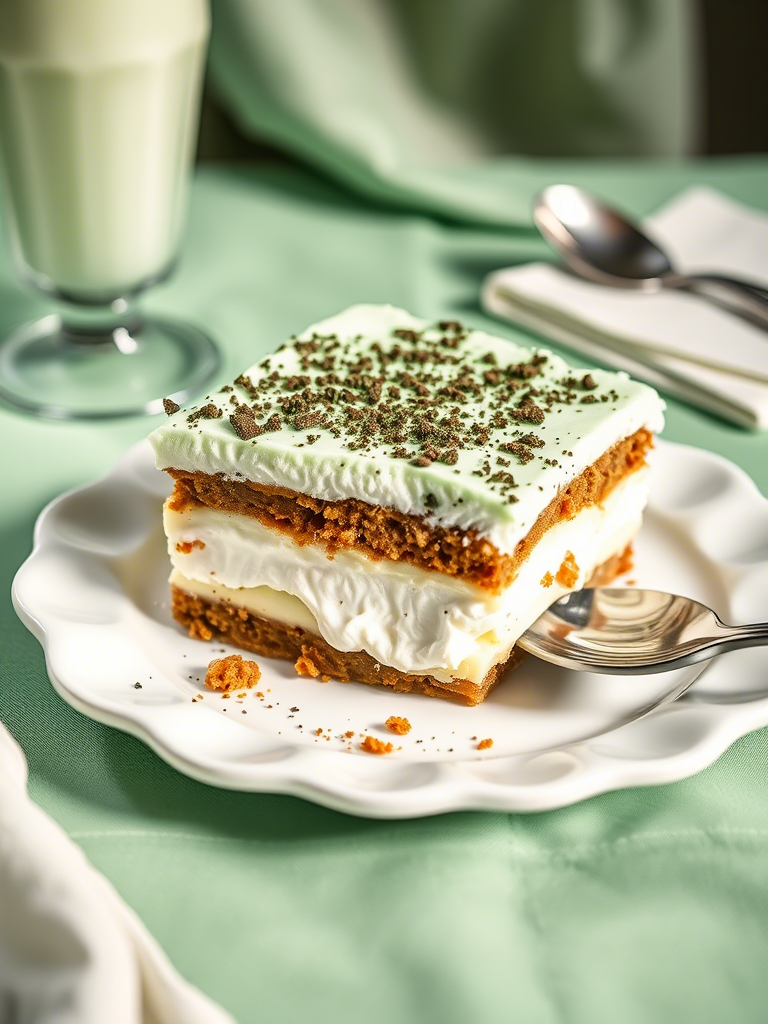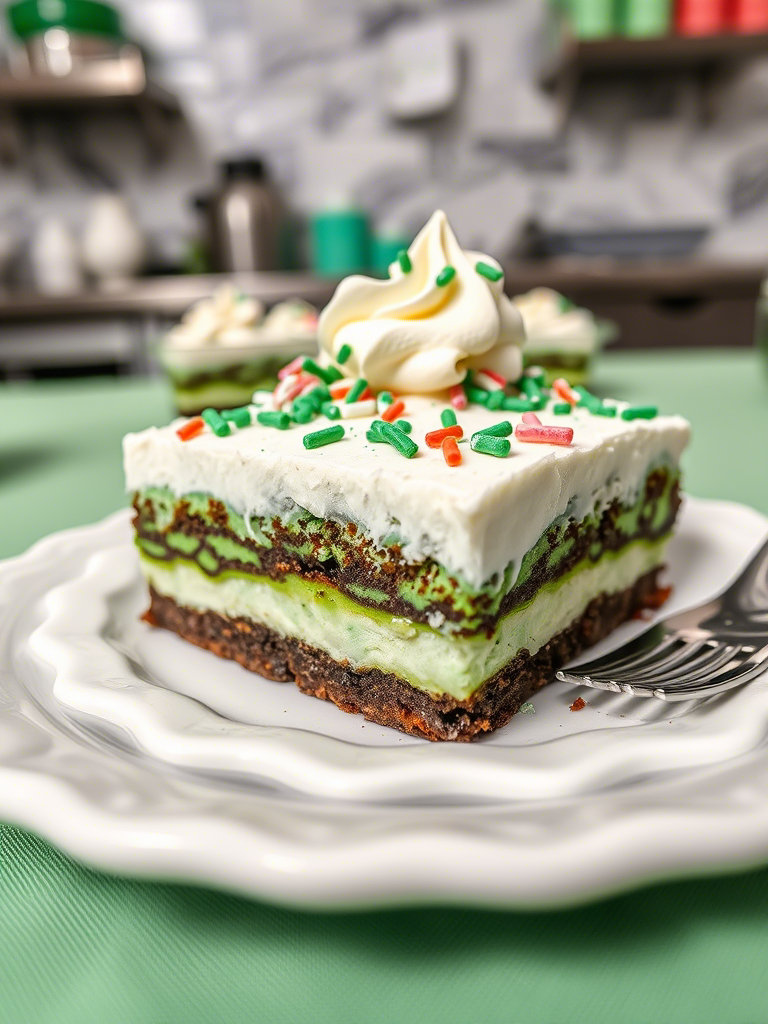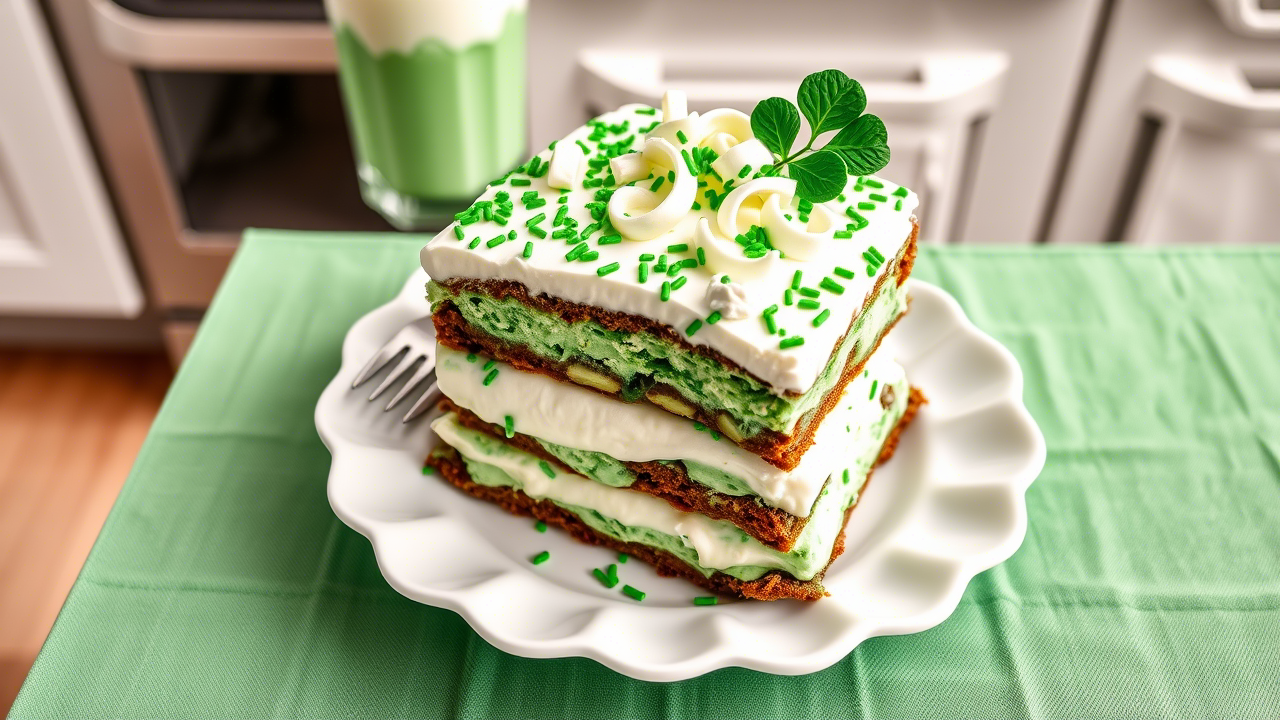Let’s be real: mint desserts are polarizing. Some folks swear by the cool, sharp zing. Others? They call it toothpaste in a dress. But love it or loathe it, one thing’s for sure—when you layer that mint with crushed cookies, velvety whipped toppings, and creamy pudding, something wild and delightful happens. That’s the magic of Shamrock Shake Dessert Lasagna. It’s not just a cute gimmick riding the green wave of March festivities. This dessert’s a calculated, tiered symphony of textures, temperature, and taste.
Pastry chefs with a modern bent are embracing it. Food stylists adore it. And dessert program directors? They’re slotting it into seasonal menus with pride. Let’s dissect why this peppermint-streaked stunner is worth its weight in crème de menthe.
Where It All Started: From Drive-Thru Drink to Dessert Dominance
The Shamrock Shake, for those living under a rock (or in a country where St. Paddy’s isn’t a culinary season), was introduced by McDonald’s back in 1970. That glowing green milkshake, laced with minty vanilla sweetness, eventually became a seasonal icon. At one point, they even threw in a leprechaun mascot. Classic.
The dessert lasagna, however, is a more recent invention. It follows the viral trend of “dessert casseroles”—multi-layered no-bake or low-bake creations that lean into the charm of old-school pudding pies but go all-out in construction. Picture the classic chocolate lasagna, but now drizzled with clover-colored nostalgia and a whiff of synthetic mint. It’s kitsch meets craft. A Frankenstein of culinary traditions. But, if built right, it works.
H2: Anatomy of a Shamrock Shake Dessert Lasagna
There’s no fixed recipe. That’s the fun bit. But certain core elements make it work.
H3: The Base — Cookie Crust
Crushed Oreos. That’s usually your bottom layer. No cream. Just the wafer, blitzed in a processor or smashed up in a bag (hey, sometimes low-tech gets better crumb texture). Mix with melted butter. Pack it into the pan. You want a crust that’s firm but not a brick. Too much butter and it’ll weep in the fridge. Too little and it crumbles like bad news.
Some chefs swap in Thin Mints or mint Jo-Jos when they can get them. Risky move—it can throw off the mint ratio if the top layers aren’t dialed in. But if you keep your mint elements balanced, it’s gold.
H3: The Cream Cheese Layer — Tang Meets Sweet
This layer is where the richness starts to build. It’s cream cheese, powdered sugar, and whipped topping. Some folks fold in a whisper of peppermint extract here. Not too much though. You’re not making VapoRub.
Color? A pale green. Not nuclear. Think more Tiffany box, less toxic waste. A touch of gel color can help you hit the right note without flavor fallout.

H3: The Pudding Layer — Where It Starts To Sing
Instant vanilla pudding, spiked with mint extract and tinted green. Some bold chefs use pistachio pudding for a nuttier take—it adds dimension, but you gotta be careful. Pistachio has its own attitude and can hijack the mint profile if you’re not watching.
Whip in some milk. The texture should be thick but spreadable. Like spackle for pastry chefs. Chill it fast so it sets up clean.
H3: The Final Layer — Whipped Topping and Crunch
Top it with more whipped topping. Or make real whipped cream if you’re feeling fancy (stabilized with gelatin if you want it to hold past the hour mark). Then, hit it with crushed Andes mints, sprinkles, or shaved chocolate. Some go wild and do green chocolate curls. That’s Vegas-level drama right there.
Serve cold. Never frozen. It’s not a semifreddo.
H2: The Science of Why It Works
There’s actual food chemistry at play here. Mint is a trigeminal stimulant—it activates the same nerve pathways as cold air. That’s why mint makes your mouth feel frosty. When paired with dairy, which coats the palate, the effect is amplified.
Layered desserts also offer contrast in every bite. A study from the Journal of Sensory Studies (2018) found that desserts with layered textures rated significantly higher in perceived indulgence than single-texture desserts. So when your fork cuts through crunchy, creamy, and airy? Your brain reads it as more luxurious—even if the ingredients are humble.
Also, green food tends to evoke ideas of freshness and health. Even if you’re eating sugar, butter, and Cool Whip. It’s a psychological trick, but one chefs can use to their advantage.
H2: Trends, Twists, and Professional Takes
You’d think this would be a home baker’s novelty. But pro kitchens are giving it serious attention.
Take Maple & Mint, a pop-up patisserie in Portland. They debuted a deconstructed Shamrock Shake Lasagna in 2024, served in parfait glasses with spun sugar nests and micro mint. Sold out in 3 days flat.
In Chicago, Sugar/Crush ran a baked version—yes, baked—with a shortbread base and a crème brûlée-style top. The flavor profile stayed minty, but they torched the topping tableside. It turned a quirky dessert into a plated experience.
And don’t forget customization. Vegan versions using coconut cream and almond milk pudding are becoming wildly popular. Some pastry chefs even fold in matcha for a more refined minty note. That’s crossover cuisine done right.
H2: Misconceptions and Mistakes to Avoid
Let’s bust a few myths.
1. All green = mint. Nope. Don’t assume just because it’s green, it’s gotta be peppermint. Spearmint, wintergreen, and even basil-mint hybrids are viable.
2. More layers = better dessert. Wrong. Too many tiers and you end up with a swampy mess. Four is your sweet spot: crust, cream cheese, pudding, topping.
3. Whipped topping is lowbrow. It might be. But it works. It’s stable, easy, and predictable. If you’re serving this in a high-traffic environment or prepping ahead, it’s your insurance policy. But yeah, if you’re running a high-end operation, go with real chantilly cream and stabilize with xanthan or gelatin.
4. It’s just for March. Why? If strawberries can be eaten year-round, so can mint. Lean into color psychology and rotate your toppings. In summer, add lime zest. Winter? Do a cocoa dusting and crushed candy canes.

H2: Cost, Scaling, and Service
Let’s talk brass tacks. This dessert is cheap. Ingredient cost is low, and it scales beautifully for banquets and catering. A 9×13 pan can serve 12–15 portions comfortably. Double that for smaller plated presentations.
Labor time is minimal if you’re batch-prepping components. It also holds up in refrigeration for up to 3 days, which makes it banquet gold. Just don’t freeze it. Texture will suffer, and layers can weep.
Quick tip for service? Dip your knife in hot water before slicing. Wipe between cuts. You’ll get cleaner edges and tighter plating.
Conclusion: More Than Just a Gimmick
Shamrock Shake Dessert Lasagna might have started as a cheeky nod to fast food nostalgia, but it’s evolved. In the right hands, it becomes a study in balance—between kitsch and craft, nostalgia and novelty, cool mint and rich dairy. It challenges assumptions and rewards smart execution.
Pastry chefs looking to push boundaries without alienating guests should consider it. It’s familiar yet fresh. Easy, but impressive. A dessert that wears its green with pride but doesn’t lean too hard on the holiday crutch.
Mint might not be everyone’s favorite. But when you stack it right, wrap it in cream, and serve it cold? You don’t just win over diners. You start conversations.
And maybe—just maybe—you give the Shamrock Shake a legacy that lives way past March.
FAQs
What is Shamrock Shake Dessert Lasagna?
A layered, mint-flavored dessert inspired by the Shamrock Shake, made with cookies, pudding, and whipped topping.
Is it only served during St. Patrick’s Day?
Nope—it can be served year-round with slight tweaks to toppings and color.
Can I make it vegan?
Yes, just use plant-based pudding, cookies, and whipped topping alternatives.
Do I have to use mint flavor?
No, but mint is what gives it the “Shamrock Shake” identity—change it and it’s a different dessert.
How long does it last in the fridge?
Up to 3 days if kept chilled and covered properly.
Can it be frozen?
No, freezing messes up the texture and makes layers separate.
What’s the best base cookie to use?
Crushed Oreos (no cream) work best for structure and taste.
Is whipped topping necessary?
Not strictly, but it adds stability—real whipped cream works if you stabilize it.
How many layers should it have?
Four layers is ideal: crust, cream cheese, pudding, and topping.
Is it good for large events?
Yes, it’s cheap, easy to scale, and holds well for catering.
Does the green color affect taste?
Nope—it’s purely visual, but balance the mint so it’s not overpowering.
Can I use pistachio pudding instead?
Sure, but it adds a nutty note—adjust mint levels so it doesn’t clash.
What’s the biggest mistake people make?
Using too much mint or making too many layers—both ruin balance.
What gives it the “lasagna” name?
The structured, stacked format that mimics the traditional savory dish.

Mariana is a passionate home cook who creates delicious, easy-to-follow recipes for busy people. From energizing breakfasts to satisfying dinners and indulgent desserts, her dishes are designed to fuel both your body and hustle.
When she’s not in the kitchen, she’s exploring new flavors and dreaming up her next recipe to share with the Foodie Hustle community.

